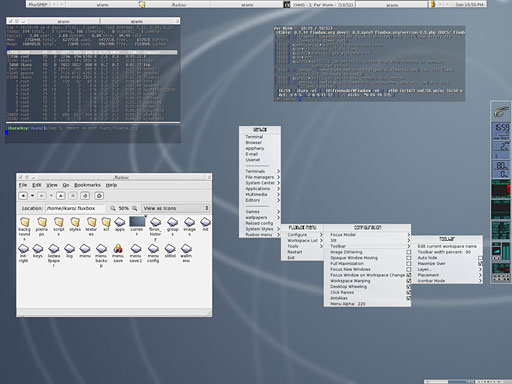Hi, my name's Ryan, and I'm a computer lover. Being in middle
school, economics dictate low-endness, so I have a few things I'd like
to talk about.
How Low Can You Go?
In my opinion, the lowest end possible computers in the Mac lineup
for everyday Internet, email, word processing, etc., is a Power Mac G3 B&W or a
PowerBook "Pismo", with
a "TiBook" or Power Mac G4 AGP (a.k.a.
"Sawtooth") a more practical minimum for graphics, audio, and such
work.
With upgrades, a Beige
G3 may be able to work modern style (USB ports, G3/G4 of at least
450 MHz, hard drive, RAM) - but just barely.
For graphics, audio, video, and iLife type tasks, I'd say you'd need
a Power Mac G4 AGP with a Radeon or GeForce 3 or better, Mac OS X
10.3.x, a 700 MHz G4 (upgrade or built in), 256 MB RAM, and a 20 GB
hard drive. It's really quite demanding.
I'm surprised at how demanding modern day tasks are; I suspect with
more optimized code you could really just use a Power Mac 6500 for minimal
graphics tasks. For word processing, probably the best types of
machines are the old ones; I like the Power Mac 7200 or 7500. The Performa 6400 also works okay.
That would be running under your choice of Mac OS 7.6, 8.1 (my
choice), OS 8.6, or OS 9.1. Mac OS 8.1 is like a speed demon on a
Performa 6400! Of course, for note jotting and bedside tasks, an
SE/30 or Mac Classic running System 6 or
7.1 is ideal.
Linux on Low-end Macs
Linux: For a bedside Internet terminal, a Power Mac 7600, 6500, a beige G3,
or PowerBook 3400 running
Fluxbox on Linux (a
window manager) and OS 9 would be great, IMHO. I wish it were
easier to set this up (if only Apple had adapted Open Firmware
earlier!)

A Fluxbox screen shot - looks quite a bit like Mac OS X!
Is High Low?
I consider my 1.25 GHz Mac
mini to be fairly low end. The ATI Radeon graphics processor is
pathetic - and the CPU's not much better. By way of comparison, Vista
is demanding 2 GB RAM and the G4 Mac mini tops out at 1 GB;
there's no support for the 30" display, FireWire 800, or SATA. Although
my mini came with a SuperDrive, the default Combo drive is fast
becoming obsolete.
My old broken 900 MHz
iBook was substantially worse. 1024 x 768 is the minimum acceptable
screen size for a new computer, and the 900 MHz G3 processor is quite
slow and may not be able to run "Leopard" (Mac OS X 10.5). It only
had 640 MB RAM and could not be expanded beyond that; somehow that is
considered low today.
Rant over, but my point is that it seems like computers just 2 or 3
years old are out-of-date by a substantial margin. Why? Why can't all
computers have a useful lifespan of 5-6 years before we have to start
using old software, tricks, and such to keep them working okay - or
even working at all?
Low End PCs
I think some PC users do care about low-end PCs; I know I do. In
some ways the PC is more flexible at certain parts of the low-end scale
- at least I think so.
PCs running Pentium IIIs at 400 MHz with just 192 MB RAM can run
Windows 2000 fairly well and Linux superbly. PCs with a PII at 233 MHz
still have lots of hope left in them with Puppy Linux or Damn Small Linux (DSL). They can
be VNC clients, MP3 players, word processors, Internet browsers,
bedside email checkers, and more.
A Pentium 150 is gonna have more trouble. Damn Small will allow
fairly well functioning word processing, money management, and a little
bit of Web browsing. Both a P150 and a 486DX2-100 can run Win 95 and
Win 98SE and word process, spreadsheet, etc. with Word 95 or Word 97
superbly. Granted, Web browsing is limited - you're pretty much stuck
with Internet Explorer 5.5.
RAM upgrades do so much to a PC - Damn Small needs at least 64 MB
for efficient running, and so does Puppy, which runs best with 128 MB.
192 MB is a minimum to use GNOME and XFce - and thus Xubuntu and Ubuntu.
A Pentium III motherboard is incredibly cheap with a 750 MHz or
faster chip and can be used to upgrade a PII or slow PIII computer. An
Athlon 2000+ motherboard is about $70 with some RAM - a great upgrade
for a Pentium III, Athlon, or K6-2 computer.
Other upgrades are also cheap. Finally, parallel port printers can
still be found, and USB port cards are supported in DSL, so no problem
there.
Living at the Low End
Overall, I agree the low-end way is very cool. Our household has
three semi-low-end computers, one of which is an Apple:
- An Athlon 1 GHz with 512 MB RAM, DVD burner, and such running
Windows XP.
- A Pentium III 750 MHz with DVD, 256 MB RAM, and 40 GB hard drive
running Ubuntu.
- A blue iBook 366
MHz G3 non-FireWire running Mac OS X 10.3.
Share your perspective on the Mac by emailing with "My Turn" as your subject.



